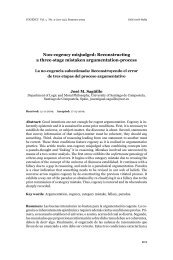Cogency v2 n2
Cogency v2 n2
Cogency v2 n2
Create successful ePaper yourself
Turn your PDF publications into a flip-book with our unique Google optimized e-Paper software.
You can’t step into the same Argument twice: Wittgenstein... / D. H. COHEN<br />
sort of categorical assertions that abound in the Tractaus for more indirect<br />
styles of writing; and he abandons the conclusions-without-proofs presentation<br />
for more dialectical arguments, complete with multiple voices articulating<br />
distinct standpoints that evolve in response to one another. These<br />
new arguments present his readers with a very different set of interpretive<br />
challenges, forced them to engage with the text in entirely new ways.<br />
The contrasting styles of writing in the Tractatus and Wittgenstein’s later<br />
works make for one of those obvious and striking differences referred to<br />
above. As noted, his writing is much more dialectical in the Investigations,<br />
but to appreciate the full extent and significance of this change, it is important<br />
not to lose sight of its continuities with the Tractatus and to see it as<br />
resulting from a series of evolutionary changes, rather than a single revolutionary<br />
paradigm shift. The evolution is evident in all aspects of Wittgenstein’s<br />
writing, everything from the metaphors and tropes he uses to the kinds of<br />
arguments he offers, and even to such matters as sentence length,<br />
paragraphing, section breaks, and even punctuation – especially with regards<br />
to dashes (and parenthetical remarks).<br />
One telling measure of the development of Wittgenstein’s dialectical style<br />
of writing from the Blue Book and Brown Book to the Investigations is in<br />
his increasing use of questions. There were virtually no questions in the<br />
Tractatus – less than two dozen all told – all of which are either rhetorical<br />
questions that the reader naturally answers (e.g., 5.555), questions to which<br />
Wittgenstein himself provides the answers (e.g., 5.511), or questions that<br />
are mentioned rather than asked (e.g., 6.211). In contrast, the very first sentence<br />
in the Blue Book is a question, and it is followed by some remarks on<br />
questions. Wittgenstein occasionally adopts the form of an internal dialogue,<br />
with passages of external dialogue, including questions, serving a variety of<br />
heuristic, explanatory, and argumentative purposes. The Brown Book follows<br />
suit, with more of the same. Wittgenstein raises questions, puzzles about<br />
them, proposes answers, raises objections to the answers, responds to the<br />
objections, and raises more questions, usually in his own voice, although on<br />
occasion he will use quotation marks as clear markers that there is a different<br />
voice behind asking the questions. The use of questions explodes in the<br />
Investigations.<br />
Wittgenstein’s use of questions and dialogue in the Investigations are<br />
noteworthy in several ways. First, there are simply a lot more questions than<br />
31








